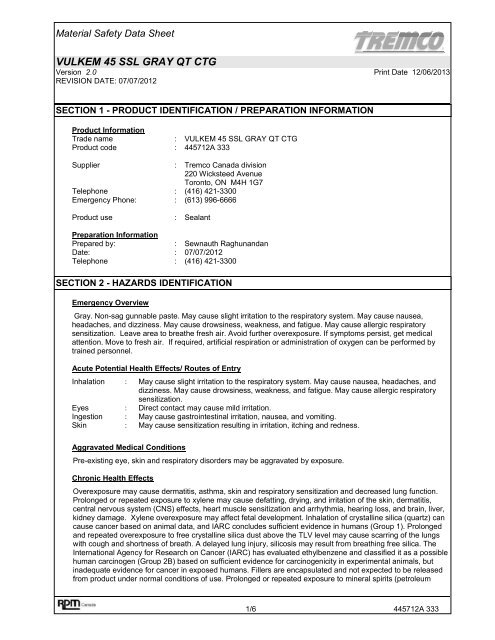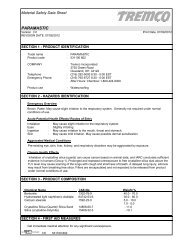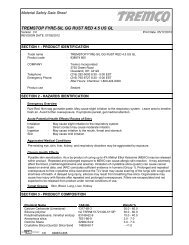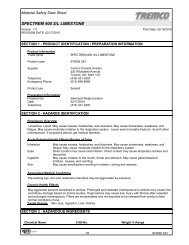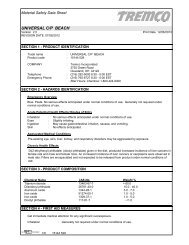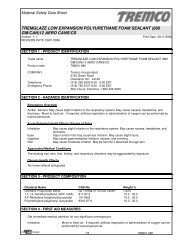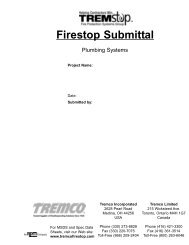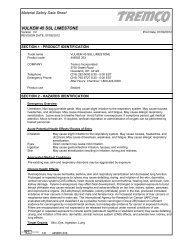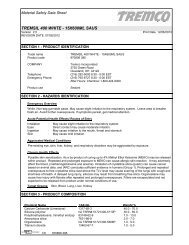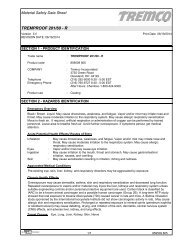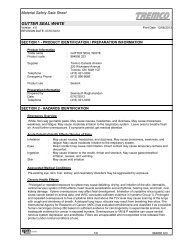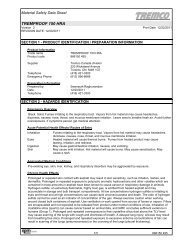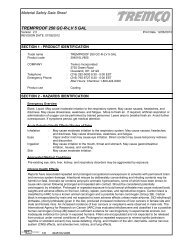Vulkem 45SSL Gray MSDS - Tremco Sealants
Vulkem 45SSL Gray MSDS - Tremco Sealants
Vulkem 45SSL Gray MSDS - Tremco Sealants
You also want an ePaper? Increase the reach of your titles
YUMPU automatically turns print PDFs into web optimized ePapers that Google loves.
Material Safety Data Sheet<br />
VULKEM 45 SSL GRAY QT CTG<br />
Version 2.0 Print Date 12/06/2013<br />
REVISION DATE: 07/07/2012<br />
SECTION 1 - PRODUCT IDENTIFICATION / PREPARATION INFORMATION<br />
Product Information<br />
Trade name : VULKEM 45 SSL GRAY QT CTG<br />
Product code : 445712A 333<br />
Supplier : <strong>Tremco</strong> Canada division<br />
220 Wicksteed Avenue<br />
Toronto, ON M4H 1G7<br />
Telephone : (416) 421-3300<br />
Emergency Phone: : (613) 996-6666<br />
Product use : Sealant<br />
Preparation Information<br />
Prepared by: : Sewnauth Raghunandan<br />
Date: : 07/07/2012<br />
Telephone : (416) 421-3300<br />
SECTION 2 - HAZARDS IDENTIFICATION<br />
Emergency Overview<br />
<strong>Gray</strong>. Non-sag gunnable paste. May cause slight irritation to the respiratory system. May cause nausea,<br />
headaches, and dizziness. May cause drowsiness, weakness, and fatigue. May cause allergic respiratory<br />
sensitization. Leave area to breathe fresh air. Avoid further overexposure. If symptoms persist, get medical<br />
attention. Move to fresh air. If required, artificial respiration or administration of oxygen can be performed by<br />
trained personnel.<br />
Acute Potential Health Effects/ Routes of Entry<br />
Inhalation : May cause slight irritation to the respiratory system. May cause nausea, headaches, and<br />
dizziness. May cause drowsiness, weakness, and fatigue. May cause allergic respiratory<br />
sensitization.<br />
Eyes : Direct contact may cause mild irritation.<br />
Ingestion : May cause gastrointestinal irritation, nausea, and vomiting.<br />
Skin : May cause sensitization resulting in irritation, itching and redness.<br />
Aggravated Medical Conditions<br />
Pre-existing eye, skin and respiratory disorders may be aggravated by exposure.<br />
Chronic Health Effects<br />
Overexposure may cause dermatitis, asthma, skin and respiratory sensitization and decreased lung function.<br />
Prolonged or repeated exposure to xylene may cause defatting, drying, and irritation of the skin, dermatitis,<br />
central nervous system (CNS) effects, heart muscle sensitization and arrhythmia, hearing loss, and brain, liver,<br />
kidney damage. Xylene overexposure may affect fetal development. Inhalation of crystalline silica (quartz) can<br />
cause cancer based on animal data, and IARC concludes sufficient evidence in humans (Group 1). Prolonged<br />
and repeated overexposure to free crystalline silica dust above the TLV level may cause scarring of the lungs<br />
with cough and shortness of breath. A delayed lung injury, silicosis may result from breathing free silica. The<br />
International Agency for Research on Cancer (IARC) has evaluated ethylbenzene and classified it as a possible<br />
human carcinogen (Group 2B) based on sufficient evidence for carcinogenicity in experimental animals, but<br />
inadequate evidence for cancer in exposed humans. Fillers are encapsulated and not expected to be released<br />
from product under normal conditions of use. Prolonged or repeated exposure to mineral spirits (petroleum<br />
1/6 445712A 333
Material Safety Data Sheet<br />
VULKEM 45 SSL GRAY QT CTG<br />
Version 2.0 Print Date 12/06/2013<br />
REVISION DATE: 07/07/2012<br />
naphtha or stoddard solvent) may cause defatting, drying, and irritation of the skin, dermatitis, central nervous<br />
system (CNS) effects, and adverse liver, kidney, and lung effects.<br />
Target Organs: Skin, Eye, Ingestion, Lung<br />
SECTION 3 : HAZARDOUS INGREDIENTS<br />
Chemical Name CAS-No. Weight % Range<br />
Stoddard solvent (Mineral Spirits) 8052-41-3 5.0 - 10.0<br />
Calcium oxide 1305-78-8 1.0 - 5.0<br />
Titanium dioxide 13463-67-7 1.0 - 5.0<br />
Xylene 1330-20-7 0.5 - 1.5<br />
Isophorone Diisocyanate 4098-71-9 0.1 - 1.0<br />
Ethylbenzene 100-41-4 0.1 - 1.0<br />
Hydrotreated heavy naphthenic<br />
distillate<br />
64742-52-5 0.1 - 1.0<br />
1,2,4-Trimethylbenzene 95-63-6 0.1 - 1.0<br />
Crystalline Silica (Quartz)/ Silica Sand 14808-60-7 0.1 - 1.0<br />
The ingredients listed above are hazardous as defined in the controlled products regulation. (CPR).<br />
SECTION 4 - FIRST AID MEASURES<br />
Get immediate medical attention for any significant overexposure.<br />
Inhalation : Leave area to breathe fresh air. Avoid further overexposure. If symptoms persist, get<br />
medical attention.Move to fresh air. If required, artificial respiration or administration<br />
of oxygen can be performed by trained personnel.<br />
Eye contact : Flush with water for at least 15 minutes while holding eye lids apart. Get medical<br />
attention immediately.<br />
Skin contact : Clean area of contact thoroughly using soap and water. If irritation, rash or other<br />
disorders develop, get medical attention immediately.<br />
Ingestion : Do not induce vomiting unless advised by a physician. Call nearest Poison Control<br />
Center or Physician immediately.<br />
SECTION 5: FIRE / EXPLOSION HAZARDS<br />
Flash point : > 93 °C, > 199 °F<br />
Method : Setaflash Closed Cup<br />
Lower explosion limit : Not available.<br />
Upper explosion limit : Not available.<br />
Autoignition temperature : Not available.<br />
Extinguishing media : If water fog is ineffective, use carbon dioxide, dry chemical or foam.<br />
Hazardous combustion<br />
products<br />
Protective equipment for<br />
firefighters<br />
: Carbon monoxide and carbon dioxide can form.Hydrocyanic acid and<br />
nitrogen oxides can form.<br />
: Use accepted fire fighting techniques. Wear full firefighting protective<br />
clothing, including self-contained breathing apparatus (SCBA).<br />
2/6 445712A 333
Material Safety Data Sheet<br />
VULKEM 45 SSL GRAY QT CTG<br />
Version 2.0 Print Date 12/06/2013<br />
REVISION DATE: 07/07/2012<br />
SECTION 6 - SPILLS / LEAKS / ACCIDENTAL RELEASE MEASURES<br />
Use appropriate protective equipment. Avoid contact with material. Scrape up and transfer to appropriate<br />
container for disposal.<br />
SECTION 7 - HANDLING AND STORAGE<br />
Prevent inhalation of vapor, ingestion and contact with skin, eyes and clothing. Preferably use entire contents<br />
in one continuous work session. Do not smoke, weld, generate sparks, or use flame near container. Change<br />
soiled work clothes frequently. Clean hands thoroughly after handling Do not store or use near food. Keep<br />
container closed when not in use. Since emptied containers retain product residue and vapor, observe<br />
precautions even after container is emptied. Store under dry warehouse conditions away from heat and all<br />
ignition sources.<br />
SECTION 8 - PREVENTIVE MEASURES/EXPOSURE CONTROLS/PERSONAL PROTECTION<br />
Personal protection equipment<br />
Respiratory protection : Wear appropriate, properly fitted NIOSH/MSHA approved organic vapor or<br />
supplied air respirator when airborne contaminant level(s) are expected to<br />
exceed exposure limits indicated on the <strong>MSDS</strong>. Follow manufacturer's<br />
directions for respirator use.<br />
Hand protection : Use suitable impervious nitrile or neoprene gloves and protective apparel to<br />
reduce exposure.<br />
Eye protection : Wear appropriate eye protection.Use safety glasses if eye contact is likely.<br />
Skin and body protection : Use disposable or impervious clothing if work clothing contamination is likely.<br />
Remove and wash contaminated clothing before reuse.<br />
Protective measures : Use professional judgment in the selection, care, and use.<br />
Engineering measures : Use general ventilation and/ or local exhaust to reduce the airborne<br />
contaminant concentration below the exposure limit listed in the <strong>MSDS</strong><br />
Exposure Limits<br />
Chemical Name CAS Number Regulation Limit Form<br />
Stoddard solvent (Mineral 8052-41-3 Ontario TWAEV: 525 mg/m3<br />
Spirits)<br />
ACGIH TWA: 100 ppm<br />
Calcium oxide 1305-78-8 Ontario TWAEV: 2 mg/m3<br />
ACGIH TWA: 2 mg/m3<br />
Titanium dioxide 13463-67-7 Ontario TWAEV: 10 mg/m3 Total dust.<br />
ACGIH TWA: 10 mg/m3<br />
Xylene 1330-20-7 Ontario TWAEV: 435 mg/m3<br />
Ontario STEV: 650 mg/m3<br />
ACGIH TWA: 100 ppm<br />
ACGIH STEL: 150 ppm<br />
Isophorone Diisocyanate 4098-71-9 Ontario TWAEV: 0.005 ppm<br />
ACGIH TWA: 0.005 ppm<br />
3/6 445712A 333
Material Safety Data Sheet<br />
VULKEM 45 SSL GRAY QT CTG<br />
Version 2.0 Print Date 12/06/2013<br />
REVISION DATE: 07/07/2012<br />
Chemical Name CAS Number Regulation Limit Form<br />
Ethylbenzene 100-41-4 Ontario TWAEV: 435 mg/m3<br />
Ontario STEV: 540 mg/m3<br />
ACGIH TWA: 100 ppm<br />
ACGIH STEL: 125 ppm<br />
Hydrotreated heavy<br />
naphthenic distillate<br />
64742-52-5 Ontario TWAEV: 1,600 mg/m3<br />
Ontario TWAEV: 5 mg/m3 Mist.<br />
Ontario STEV: 10 mg/m3 Mist.<br />
ACGIH TWA: 5 mg/m3 Inhalable fraction.<br />
1,2,4-Trimethylbenzene 95-63-6 Ontario TWAEV: 123 mg/m3<br />
ACGIH TWA: 25 ppm<br />
Crystalline Silica (Quartz)/<br />
Silica Sand<br />
14808-60-7 Ontario TWAEV: 0.10 mg/m3 Respirable fraction.<br />
ACGIH TWA: 0.025 mg/m3 Respirable fraction.<br />
SECTION 9 - PHYSICAL AND CHEMICAL PROPERTIES<br />
Physical State<br />
: Liquid (paste)<br />
Form<br />
: Non-sag gunnable paste<br />
Color<br />
: <strong>Gray</strong><br />
Odor<br />
: Petroleum Solvent<br />
pH<br />
: Not available.<br />
Vapour pressure<br />
: Not available.<br />
Vapor density<br />
: Heavier than air<br />
Melting point/range<br />
: Not available.<br />
Freezing point<br />
: Not available.<br />
Boiling point/range<br />
: Not available.<br />
Water solubility<br />
: Insoluble<br />
Evaporation Rate:<br />
: Not available.<br />
Specific Gravity : 1.32<br />
% Volatile Weight : 7 %<br />
SECTION 10 - REACTIVITY / STABILITY<br />
Substances to avoid<br />
Stability<br />
Hazardous polymerization<br />
: Amines.Water or moisture and oxidizing agents.Alcohols.Strong<br />
acids.Strong bases.<br />
: Material is stable under normal storage, handling, and use.<br />
: Will not occur.<br />
SECTION 11 - TOXICOLOGICAL INFORMATION<br />
Xylene, CAS-No.: 1330-20-7<br />
4/6 445712A 333
Material Safety Data Sheet<br />
VULKEM 45 SSL GRAY QT CTG<br />
Version 2.0 Print Date 12/06/2013<br />
REVISION DATE: 07/07/2012<br />
Acute oral toxicity (LD-50 oral) 4,300 mg/kg ( Rat ) 1,590 mg/kg ( Mouse ) 6,670 mg/kg (<br />
Rat ) 3,523 - 8,600 mg/kg ( Rat ) 5,627 mg/kg ( Mouse )<br />
Acute inhalation toxicity (LC-50) 6,350 mg/l for 4 h ( Rat ) 3,907 mg/l for 6 h ( Mouse ) 8,000<br />
mg/l for 4 h ( Rat )<br />
Isophorone Diisocyanate, CAS-No.: 4098-71-9<br />
Acute oral toxicity (LD-50 oral) 2,500 mg/kg ( Mouse ) 1,000 mg/kg ( Rat )<br />
Acute inhalation toxicity (LC-50) 0.033 mg/l for 4 h ( Rat ) 0.123 mg/l for 4 h ( Rat )<br />
Acute dermal toxicity (LD-50 dermal) 1,060 mg/kg ( Rat )<br />
Ethylbenzene, CAS-No.: 100-41-4<br />
Acute oral toxicity (LD-50 oral) 5,460 mg/kg ( Rat ) 3,500 mg/kg ( Rat )<br />
Acute dermal toxicity (LD-50 dermal) 17,800 mg/kg ( Rabbit )<br />
SECTION 12 - ECOLOGICAL INFORMATION<br />
No Data Available<br />
SECTION 13 - WASTE DISPOSAL CONSIDERATIONS<br />
Disposal Method : Dispose as hazardous waste according to all local, state, federal and provincial<br />
regulations.<br />
SECTION 14 - TRANSPORTATION / SHIPPING DATA<br />
TDG:<br />
Not Regulated<br />
CFR / DOT:<br />
Not Regulated<br />
IMDG:<br />
Not Regulated<br />
SECTION 15 - REGULATORY INFORMATION<br />
North American Inventories:<br />
All components are listed or exempt from the TSCA inventory.<br />
This product or its components are listed on, or exempt from the Canadian Domestic Substances List.<br />
5/6 445712A 333
Material Safety Data Sheet<br />
VULKEM 45 SSL GRAY QT CTG<br />
Version 2.0 Print Date 12/06/2013<br />
REVISION DATE: 07/07/2012<br />
Canadian Regulations:<br />
WHMIS Classification : D2A, D2B<br />
This is a "controlled product" under the Canadian Workplace Hazardous Materials Information System<br />
(WHMIS).<br />
This product has been classified in accordance with the hazard criteria of the Controlled Products Regulations<br />
(CPR) and the <strong>MSDS</strong> contains all of the information required by the CPR.<br />
Other Regulations:<br />
Regulatory VOC (less water and<br />
exempt solvent)<br />
: 105 g/l<br />
SECTION 16 - OTHER INFORMATION<br />
HMIS Rating :<br />
Health 2 0 = Minimum<br />
Flammability 2<br />
1 = Slight<br />
Reactivity 0<br />
2 = Moderate<br />
PPE<br />
3 = Serious<br />
4 = Severe<br />
Further information:<br />
For Industrial Use Only. Keep out of Reach of Children. The hazard information herein is offered solely for the<br />
consideration of the user, subject to their own investigation of compliance with applicable regulations, including<br />
the safe use of the product under every foreseeable condition.<br />
Prepared by: Sewnauth Raghunandan<br />
Legend<br />
ACGIH - American Conference of Governmental Hygienists<br />
DOT - Department of Transportation<br />
DSL - Domestic Substance List<br />
EPA - Environmental Protection Agency<br />
HMIS - Hazardous Materials Information System<br />
IARC - International Agency for Research on Cancer<br />
MSHA - Mine Safety Health Administration<br />
NDSL - Non-Domestic Substance List<br />
NIOSH - National Institute for Occupational Safety and Health<br />
NTP - National Toxicology Program<br />
OSHA - Occupational Safety and Health Administration<br />
PEL - Permissible Exposure Limit<br />
RCRA - Resource Conservation and Recovery Act<br />
STEL - Short Term Exposure Limit<br />
TLV - Threshold Limit Value<br />
TSCA - Toxic Substances Control Act<br />
TWA - Time Weighted Average<br />
V - Volume<br />
VOC - Volatile Organic Compound<br />
WHMIS - Workplace Hazardous Materials Information System<br />
6/6 445712A 333


